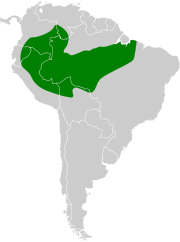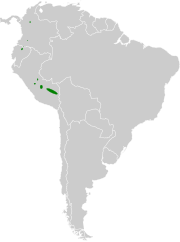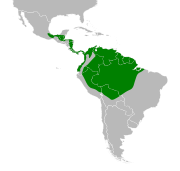

| Tinamus | |
|---|---|

| |
| Great tinamou (Tinamus major) | |
| Scientific classification | |
| Domain: | Eukaryota |
| Kingdom: | Animalia |
| Phylum: | Chordata |
| Class: | Aves |
| Infraclass: | Palaeognathae |
| Order: | Tinamiformes |
| Family: | Tinamidae |
| Subfamily: | Tinaminae |
| Genus: | Tinamus Hermann, 1783 |
| Type species | |
| Tetrao major[1] Gmelin, JF, 1789 | |
| Species | |
|
see text | |
Tinamus is a genus of birds in the tinamou family Tinamidae. This genus comprises some of the larger members of this South American family.
The genus Tinamus was introduced in 1783 by the French naturalist Johann Hermann.[2] The type species was subsequently designated as the great tinamou.[3][4] Hermann based his name on "Les Tinamous" used by Georges-Louis Leclerc, Comte de Buffon in his Histoire Naturelle des Oiseaux. The word『Tinamú』in the Carib language of French Guiana was used for the tinamous.[5][6]
The genus contains five species:[7][8]
| Common name | Scientific name and subspecies | Range | Size and ecology | IUCN status and estimated population |
|---|---|---|---|---|
| White-throated tinamou | Tinamus guttatus (Pelzeln, 1863) |
southeastern Colombia, southern Venezuela, Amazonian Brazil, and northern Bolivia
|
Size: Habitat: Diet: |
NT
|
| Grey tinamou | Tinamus tao Temminck, 1815 Four subspecies |
northern and western Brazil, eastern Ecuador, eastern Peru, northern Bolivia, Colombia east of the Andes, northwestern and northeastern Venezuela, and northwestern Guyana
|
Size: Habitat: Diet: |
VU
|
| Solitary tinamou | Tinamus solitarius (Vieillot, 1819) |
northeastern Argentina (Misiones), eastern Paraguay, eastern Brazil
|
Size: Habitat: Diet: |
NT
|
| Black tinamou | Tinamus osgoodi Conover, 1949 Two subspecies
|
the Andes of southeastern Peru and the Andes of Colombia
|
Size: Habitat: Diet: |
VU
|
| Great tinamou | Tinamus major (Gmelin, JF, 1789) Twelve subspecies
|
from southeastern Mexico through Panama, excluding Honduras and from Ecuador to French Guiana, parts of Brazil and northern Bolivia
|
Size: Habitat: Diet: |
LC
|
|
Palaeognath genera
| |||||||||||||||||||||||||||||||||||||||
|---|---|---|---|---|---|---|---|---|---|---|---|---|---|---|---|---|---|---|---|---|---|---|---|---|---|---|---|---|---|---|---|---|---|---|---|---|---|---|---|
| |||||||||||||||||||||||||||||||||||||||
| |||||||||||||||||||||||||||||||||||||||
| |||||||||||||||||||||||||||||||||||||||
| |||||||||||||||||||||||||||||||||||||||
| |||||||||||||||||||||||||||||||||||||||
| Tinamus |
|
|---|---|
| Authority control databases: National |
|
|---|